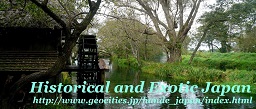The battle in Sekigahara in 1600 was one of the most decisive battles in Japanese History.
Just two years after the death of TOYOTOMI Hideyoshi, who governed Japan, the battle broke out between TOKUGAWA Ieyasu and ISHIDA Mitsunari, retainer of TOYOTOMI Hideyoshi.
Approximately 80,000 combatants participated on each side, a total 160,000.
The battle lasted just a half day and TOKUGAWA Ieyasu (Eastern Army) defeated ISHIDA Mitsunari (Western Army).
This was the end of internal wars in Japan during the middle age for more than 100 years.
In 1603, TOKUGAWA Ieyasu established his government "Edo Bakufu" and it continued in peace until 1868. This period is called the EDO Age.
The location of Sekigahara is at the west end of Gifu Prefecture, near the border with Shiga Prefecture.
Sekigahara is the bottleneck between West and East Japan.
The route through Sekigahara was the only route for large armies to march between Nagoya and Osaka in the past.
Just before the Sekigahara-Battle, TOKUGAWA Ieyasu was in the Kanto Area and marched west through Nagoya.
ISHIDA Mitsunari stayed in Osaka and planned to conduct a battle in Sekigahara.
This issue will explain the outline of the battle of Sekigahara and historical spots, for example, sites of forces of key commanders, monuments and mounds.
The Original Position of TOKUGAWA Ieyasu
At first, TOKUGAWA Ieyasu positioned to the east of Sekigahara.
The location was more than two kilometers away from the main battle area.
The position of TOKUGAWA Ieyasu was on the hill across the street.
As the location was far from the main battle area, it was difficult to see the area.
The Positions of II Naomasa and MATSUDAIRA Tadamasa
Near to Sekigahara Station, the positions of II Naomasa and MATSUDAIRA Tadamasa were located.
On September 15, 1600 at 8:00AM, when II and MATSUDAIRA's force marched to UKITA's force, the battle started.
A red banner is of II's force. II's force were so brave that their enemies were afraid of the red banner.
Near to these positions, the burial mound for severed heads of dead soldiers was located.
It is said that 8,000 to 20,000 soldiers died at this battle.
TAKENAKA Shigekado, who was the feudal lord of Sekigahara area, made the mound to pray for them to rest in peace.
The Final Position of TOKUGAWA Ieyasu
TOKUGAWA Ieyasu moved 200 meters north-east of the positions of II Naomasa and MATSUDAIRA Tadamasa from the original position, when the tide of the battle had turned in Ieyasu's favor.
The site of his final position was being well maintained.
Okayama Signal-Fire Place
Five hundred meters to the north of Sekigahara Station, Okayama Signal-Fire Place was located.
When the battle began, the signal fire was set off at this place.

 Home Page in Japanese: "Shane's HomePage"
Home Page in Japanese: "Shane's HomePage"

 Home Page in Japanese: "Shane's HomePage"
Home Page in Japanese: "Shane's HomePage"